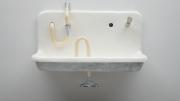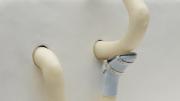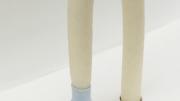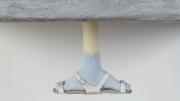Robert gober was born in 1954 in Wallingford, Connecticut, and studied at Middlebury College. He now lives and works in New York City. Gober “is arguably the most important sculptor/artist of his generation,” declares Mary Schneider Enriquez, Houghton associate curator of modern and contemporary art at the Harvard Art Museums. He created the work shown here, Untitled, dated 2009 to 2010, out of plaster, beeswax, human hair (on the legs but not visible in the photographs), cotton, leather, aluminum pull tabs, and enamel paint.
The sink is featured in a new installation in the Sackler Museum’s first-floor galleries of recent pieces by Gober, Felix González-Torres, Doris Salcedo, and other contemporary artists, as well as works that haven’t been shown for years by such modern masters as Josef Albers, Hans Arp, and Robert Rauschenberg.
One may listen on one’s cellphone to a guided tour of the exhibition while exploring it. Schneider Enriquez provides the commentary on the sink, saying, in part, “In this work, Gober combines several of his interests and signature, almost iconic, elements: a large-scale sink and five feet/legs, apparently belonging to a small child. The feet and legs wind in a deeply creepy serpentine way in and out of the non-functional apertures, mimicking the missing plumbing.…The sculpture presents us with an image so improbable, an object so peculiar, that it is as if the sculpture is functioning like a dream, in which objects are condensed one onto another such that they become impossible to separate and explain in any coherent narrative.” Indeed, she says, “The unyielding way in which Gober plays with very strong themes of sexuality and the body—while at the same time making work that defies a hierarchical narrative—is one of his oeuvre’s great strengths.”











